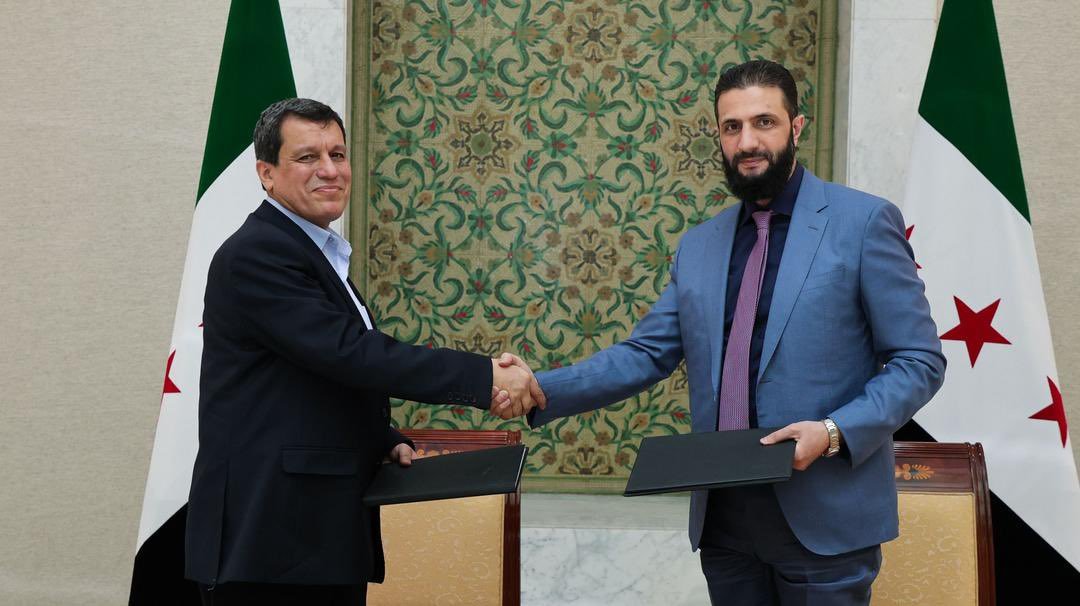Damascus-SDF Agreement Signals Turkey’s Strategic Compromise: PKK Dissolution in Turkey, SDF Survival in Syria

The newly announced agreement signed today between Ahmad Al-Shara’a, president of the HTS-led administration in Damascus, and Mazloum Abdi, commander of the Syrian Democratic Forces (SDF), appears to have been in the works for some time. It is likely an extension and integral part of the broader Turkish peace negotiations with the PKK. This development sheds more light on how the SDF issue fits within the wider Turkey-PKK peace process, revealing a more pragmatic and creative approach by Turkey than previously understood. The U.S. and Turkey, as well as Damascus and the SDF, have been engaged in negotiations over the future of the SDF region since late December, following the collapse of Assad’s regime, Reuters reported at the time.
While the agreement could be viewed as a significant victory for the SDF based on the published Arabic content, it also provides Al-Shara’a with much-needed relief as he confronts multiple resistance pockets throughout Syria, with the SDF issue being the most significant. In essence, it represents a mutually beneficial arrangement, though one fraught with potential complications that could emerge at any moment and unlikely to serve as a definitive resolution to the SDF regional question. What remains evident is that Turkey and the United States, have played instrumental roles in facilitating this agreement and establishing a middle ground to resolve the issue peacefully.
For the SDF, this represents a major victory for one simple reason: the agreement specifies integrating the SDF into the Syrian state without mentioning absorbing the SDF or requiring fighters to individually join the Syrian forces—a condition the Syrian Defence Minister had repeatedly insisted upon previously. Consequently, the SDF will likely be integrated as unified, cohesive forces into the new Syrian Army, which aligns precisely with the SDF’s demands; they have expressed willingness to become part of the new administration and integrate into it provided the SDF remains intact as a force and joins the new Syrian army as a specialized division. While the agreement does not explicitly define what “integration” entails, this ambiguity will likely become a contentious issue in the future and appears to have been deliberately left vague, as otherwise reaching an agreement would not have been possible. Although this does not represent a final resolution for the SDF, it constitutes a crucial first step toward establishing themselves as a de facto region with special status.
For Al-Shara’a, the agreement provides critical breathing room, enabling him to shift attention away from the SDF to address more immediate threats, such as the growing pro-Assad insurgency in coastal areas and the unchecked actions of pro-Turkish Syrian National Army militias implicated in war crimes, damaging the moderate image Al-Shara’a seeks to cultivate. Moreover, this agreement allows Al-Shara’a to consolidate his currently fragile authority and confront other pressing internal challenges, including managing relations with Sunni Southern Front militia leader Ahmad al-Awda and addressing tensions involving the Druze minority. Compromise with the SDF, supported by the US, was necessary, as engaging in military conflict with the SDF would trigger severe Western media backlash and jeopardize Al-Shara’a’s efforts to gain international legitimacy and relief from sanctions. Furthermore, under this agreement, the Syrian government will reassume control over key border crossings, airports, and oilfields—an important revenue source for the economically strained Damascus government. However, revenue-sharing arrangements will likely become another contentious issue as practical realities on the ground emerge, given that the SDF region also requires income to sustain its administration.
Given that this agreement follows a recent breakthrough in Turkish-PKK peace talks, with the SDF issue being a primary obstacle, Turkey’s involvement appears certain. Additionally, the US has been quietly negotiating with Turkey regarding the SDF region, particularly given the American intention to withdraw troops. Thus, this agreement likely emerged from these US-Turkish negotiations. Still, the deliberately ambiguous terms leave room for future interpretation struggles, allowing whichever party gains greater leverage to shape implementation to their advantage. Nevertheless, it represents a necessary temporary arrangement for both sides to avoid military confrontation.
As outlined in our earlier analysis, Turkey’s strategy in Syria is focused on integrating Syrian Kurds into a new Syrian state rather than directly eliminating them, making today’s agreement not entirely unexpected. Another interesting aspect to observe is whether, as previously argued, Turkey would attempt to “position itself not as an adversary of Syrian Kurds but as a ‘protector’ of their interests within a reconstituted Syria” after the PKK peace talks inside Turkey are finalized. It has been suggested that this is part of a broader strategic realignment, potentially forming an emerging Turkish-Kurdish regional alliance that could significantly alter the balance of power in the Middle East.
Overall, it appears that Turkey has strategically accepted an offshoot of the PKK in Syria, provided that the original PKK structure within Turkey dissolves. This clarifies how Ocalan so readily accepted and advocated for the PKK’s dissolution—it represented a difficult decision to sacrifice the parent organization to ensure the survival of its offspring.
Syrian Government-SDF Agreement
An Agreement Between the Syrian State and the Syrian Democratic Forces
Damascus, March 10, 2025









